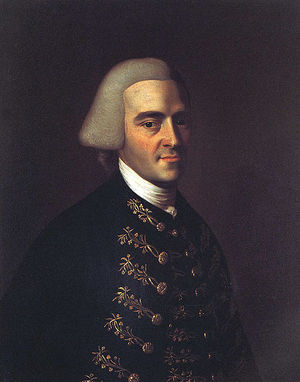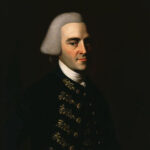John Hancock was one of the founding fathers of the United States of America. He is best known for his large signature on the Declaration of Independence, but that was hardly his biggest contribution to the founding of the nation. He was outspoken for the cause of freedom and he was at the forefront of many rebel actions that took place in Massachusetts prior to and during the Revolutionary War. John Hancock was a politician and a successful merchant, but above all, he was a dedicated and active patriot.
John Hancock was born on January 12, 1737, in Quincy, Massachusetts. He was the son of a clergyman and was an orphan at a very young age. His uncle, Thomas Hancock, was the owner of the Hancock Counting House and a successful merchant. When John’s parent were gone, Thomas took the young boy under his wing. Thomas was a patron of Harvard College and he saw to it that his nephew was educated there. John got an education in business at Harvard College and graduated in 1754, when he was 17 years old.
John Hancock went to work for his uncle when he got out of school and continued to do so until his uncle died, when John was 27 years old. John was the benefactor of Thomas’ estate, making him the richest man in Massachusetts after his uncle’s death. He may have even been the wealthiest man in New England. This put Hancock in a strange position when rebellion reared its head in Massachusetts as he could easily afford the taxes that were causing the rebellion. John was an observer of the goings on between the rebels and the British until he began to realize that the heavy taxes that were being imposed by the British were affecting his friends and employees. It was then that John Hancock became involved with “The Sons of Liberty.”
Despite his wealth, John had become a leading figure in the rebellion. When the Boston Massacre occurred in 1770, Hancock became much more vocal in his opposition of the British. He gave a speech at the funeral of the victims of the massacre that proved to the British that he was, without a doubt, a rebel. John Hancock was described as a virtuous man and a dedicated patriot by his peers and his actions during this time reflected that.
In October of 1774, John Hancock was unanimously elected president of the provincial congress of Massachusetts. He quickly became wanted for arrest by British troops for his rebellious behavior. In fact, it was thought that the British were on their way to arrest him and Samuel Adams on the night of the Battle of Lexington and Concord, April 18, 1775. Very shortly after that night, John Hancock was elected to the Continental Congress. That year he married Dorothy Quincy on August 23. The couple would go on to have two children together, one boy and one girl. Their daughter, Lydia, died in infancy; their son, John, died at the age of nine.
The following year, 1776, John Hancock was elected President of the Continental Congress. However, he was forced to resign because of health problems in 1777. In 1780 he became the first governor of Massachusetts. He was re-elected to this office four more times before he resigned because of his health. He became governor again in 1787 and stayed governor of Massachusetts until he passed away on October 8, 1793.
The most important thing to remember about John Hancock is that he could’ve easily opposed the revolution. He certainly had the money to do so. Instead, he risked death by signing the Declaration of Independence and he even donated large sums of his fortune to the Massachusetts volunteer army. He was certainly one of the leading figures of the American Revolution, even if he is largely remembered for his signature.




